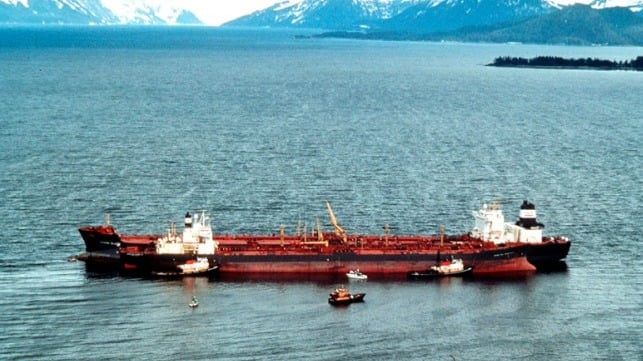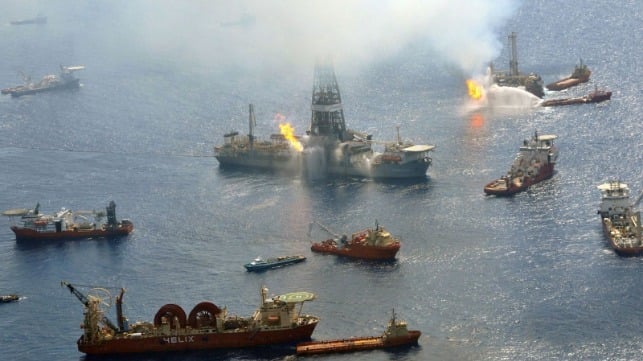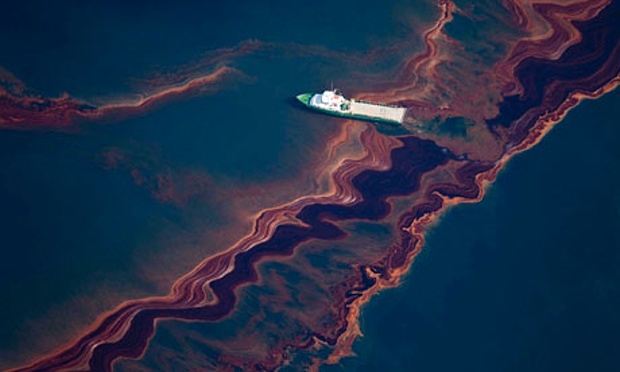12 Years Later: The Deepwater Horizon Spill
"Even Exxon Valdez pales in comparison to the volume, scale, number of Coast Guard resources, how much time has been devoted to [Deepwater Horizon]—all far exceed any previous event." - Capt. Duke Walker, Federal On-Scene Coordinator, U.S. Coast Guard, 2012
On the evening of April 20, 2010, the Deepwater Horizon oil rig blew up at the Macondo well site, 45 miles southeast of Venice, Louisiana. The explosion resulted in the deaths of 11 workers and, within two days, the loss of the rig. The resulting spill of over 200 million gallons of crude oil became the largest discharge of oil in U.S. waters.
A century earlier, petroleum products had fueled tremendous growth in industrial, government and civilian uses. Oil products became common ship fuel and cargo and, offshore oilrigs grew in numbers as land-based reserves dried up.
The Coast Guard’s role in oil and chemical spill response officially began in 1924, when Congress passed the Oil Pollution Act. This act included the first federal statutes regulating the discharge of fossil fuels from seagoing vessels. In 1948, Congress passed the Federal Water Pollution Control Act to protect public water supplies for public, agricultural, recreational and industrial uses. Coast Guard veterans will remark how laws mandating the service’s search and rescue mission were written in blood, but the service’s pollution response mission laws were written in oil.
After World War II, chemical spills and hazardous waste events began to occur frequently. Major spills in the 1960s brought attention to oil and chemical pollution, including the tanker Torrey Canyon oil spill in 1967 and the 1969 fire on Cleveland’s polluted Cuyahoga River. The 1969 Santa Barbara Oil Spill focused attention on the dangers of spills from offshore oil rigs. With these environmental disasters came greater awareness of chemical pollution spurring enactment of the U.S. National Oil and Hazardous Substances Pollution Contingency Plan (a.k.a. “NCP”) in 1968 and, in 1970, passage of the Water Quality Act and establishment of the nation’s annual Earth Day observance.
By the 1970s, tanker oil spills averaged nearly 80 per year worldwide. With these frequent spills came regulation of oil tankers and better technology for responding to spills. Congress tasked the Coast Guard with monitoring unauthorized substance discharge, enforcing ballast water regulations and ensuring that commercial vessels met U.S. environmental standards. In 1972, Congress made sweeping amendments to the Water Pollution Control Act, which came to be known as the Clean Water Act and resulted in establishment of the Coast Guard’s National Strike Force (NSF). In the 1970s and 1980s, the NSF’s oil and chemical spill responsibility expanded under several more environmental protection laws passed by Congress.
In 1989, the tanker Exxon Valdez ran onto a rock ledge near Valdez, Alaska, causing the worst oil spill in U.S. waters up to that time. The disaster led to passage of the Oil Pollution Act of 1990 (OPA 90). OPA 90 regulations created the Oil Spill Lability Trust fund and codified the “polluter pays” principle. OPA 90 also required alcohol and drug abuse monitoring of licensed mariners, and established legal penalties and a claims system for oil spill remediation. Enforcement of OPA 90 and protection of U.S. territorial waters became a vital part of the Service’s mission and led to a more robust Coast Guard response capability.

Picture of the tanker Exxon Valdez in 1989 after she ran aground in Prince William Sound, Alaska, and spilled 15 million gallons of crude oil. (U.S. Coast Guard)
After Exxon Valdez, Coast Guard assets and personnel continued to respond to all kinds of oil and hazardous material releases, even some beyond U.S. waters. These events included the sabotaged oilrigs of the 1990 Persian Gulf War and consequent oil spills—considered one of the largest discharges of oil in history. Other spills included those caused by hurricanes Floyd, Katrina and Rita; barge and tanker oil spills of the 1990s and early 2000s; and aviation accidents, such as the 1999 Egypt Air and 2000 Alaska Airlines crashes.
Coast Guard units, including the NSF, played a leading role in responding to the Haiti Earthquake in 2010. That same year, the Deepwater Horizon rig explosion occurred. The resulting spill is considered the world’s largest maritime oil spill and the largest environmental disaster in U.S. history. The Deepwater gusher spewed oil into the Gulf of Mexico at a rate of 60,000 barrels per day for nearly 90 days. The oil slick covered thousands of square miles of water and nearly 4,500 miles of Gulf shoreline.

Relief well drilling operations at the Deepwater Horizon response site (USCG)

Daniel Beltra / Greenpeace
From April 2010 through April 2014, the Coast Guard led the effort to clean and evaluate shoreline segments along the Gulf of Mexico. In 2012 and in 2013, the shoreline-cleaning program collected around seven million pounds of oily material. By the summer of 2013, shoreline remediation was deemed complete on the Gulf shores of Texas, Mississippi, Alabama and Florida. In 2014, the program collected around 30,000 pounds of oily material, about one percent of the previous year’s total. By 2014, the bulk of oily material found consisted primarily of small tar balls dispersed along the shorelines. By then, it became difficult to distinguish between oil from Deepwater Horizon and oil from other sources found along the shoreline. By late February 2015, the Coast Guard shifted operational oversight of response effort to local commands along the Gulf Coast.
The Coast Guard’s response to the Deepwater Horizon spill became the largest for an environmental disaster in the Service’s history. At the height of the effort, the Coast Guard-led command oversaw an armada of over 6,000 vessels, including skimmers, vessels of opportunity, research vessels, Coast Guard cutters, and specialized vessels. This command also established an Aviation Coordination Center that oversaw more than 120 aircraft vital to the response effort. To ensure the flow of commerce in the impacted area, the Coast Guard established a Marine Transportation System Recovery Unit. The combined efforts of these assets involved nearly 50,000 Coast Guard and civilian personnel.
Today, as part of its homeland security obligations, the Coast Guard responds to human and environmental impacts of oil discharges, hazardous material releases, and other disasters. The Coast Guard remains ready, relevant and responsive to adapt and expand its environmental protection mission to ever-changing natural and manmade threats to the nation and its marine environment.
William Thiesen is the Coast Guard Atlantic Area historian. This article was first released in 2020, and it is reproduced here courtesy of Coast Guard Compass. The original is no longer available online.
The opinions expressed herein are the author's and not necessarily those of The Maritime Executive.
